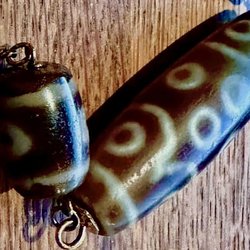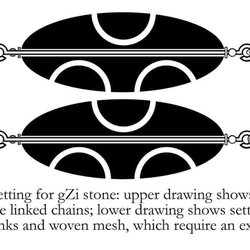

gZi གཟི་ stones
These ancient gZi གཟི་ stones were given to Ngak’chang Rinpoche by Kyabjé Düd’jom Rinpoche Jig’drèl Yeshé Dorje; Kyabjé Künzang Dorje Rinpoche; Jomo Sam‘phel Déchen Rinpoche; Kyabjé Dilgo Khyentsé Rinpoche; and ‘Khordong gTérchen Tulku Chhi’mèd Rig’dzin Rinpoche.
In relation to gZi གཟི་ please be aware that dZi is a bogus spelling created for marketing Himalayan gZi གཟི stones.
gZi གཟི is pronounced Zi or Zee.
gZi གཟི is not pronounced Dzi or Dzee — and, dZi is NOT an ‘alternative spelling’ for gZi གཟི་— nor is it a ‘modern spelling’ as certain business people have attempted to explain.
dZi cannot be found as a word in any Tibetan or Dzongkha (Bhutanese) dictionary. If there were such a word, it would have to be spelt d.zi in transliteration — and that does not exist in any written form in Tibetan or Dzongkha.
The syllable Dzi does exist – but it is one letter—ཛི་—not two letters.
Moreover ཛི only exists in conjunction with other syllables; such as ‘kam po dzi’ གམ་པོ་ཛི་ – the Tibetan word for Cambodia.
There are other ‘letter clusters’ which contain the syalble Dzi ཛི – such as:
rDzi – ཛི་ wind;
rDzi bo – ཛི་བོ་ herdsman or shepherd; and,
rDzi ma – ཛི་མ་ eye-lashes.
According to ’Khordong gTéchen Tulku Chhi’mèd Rig’dzin Rinpoche, some marketing person or persons thought the ‘Wojkowitz’ capitalisation of the root letter ‘Zi’ ཟི་ was ‘cute’ —— but that the correct ‘g suffix’ made the word gZi གཟི either intimidating or unpronounceable for the Western people who were thought comprise the target market.
Few people seem to use the ‘Wojkowitz transliteration’ of Tibetan now — the Aro gTér Tradtion being one such group. Anyone using it therefore, is either antiquarian or ignorant of the fact that the ‘Turrell Wylie’ system of transliteration is now more-or-less the universal form.
To recap: If one wished to write gZi གཟི in phonetic it would be ‘zi’ or even ‘zee’ – but not dZi, because the word gZi གཟི does not sound like Dzi.
gZi གཟི stones are patterned stone that are akin to agate. They are mainly lozenge shaped – but can be round, or cylindrical.
They date——according to ‘Khordong gTérchen Tulku Chhi’mèd Rig’dzin Rinpoche——to 3,000 BC.
They originate mainly in the TransHimalayan regions of Tibet, Bhutan, Sikkim, Ladakh, and Nepal — but also from Afghanistan.
A common misconception is that gZi གཟི stones date to the 8th century.
This error dervies from ‘The History Of Beads’ by Lois Sherr Dubin, where gZi གཟི are placed in Tibetan history in the 700s AD in line with the introduction of Buddhism. Tibet never permitted archæological digs so scientific dating was not possible.
gZi གཟི stones are precious in Vajrayana culture because of their patterning – and it is the patterning on gZi གཟི stones that is the subject of much controversy amongst those who desire a scientific explanation.
The mystery of gZi གཟི stones is how the surface pattern were created without cracking the stone.
gZi གཟི stones belong somewhere within the Silicate family. In mineralogy, silica (silicon dioxide SiO2) is a silicate mineral naturally found as quartz and variants of quartz – such as chalcedony, agate and carnelian.
All Silicate stone is vulnerable to shattering when exposed to heat.
Techniques for heating Silicate without damaging them has only recently been discovered. Sophisticated technology is required as the stone has to be heated in a vacuum.
The gZi གཟི stone is porous – so air and moisture exist within the stone and this is what leads to them shattering when heated. When heated in a vacuum however, the air is removed, which reduces the risk shattering. As gZi གཟི stones were heated at high altitude where the air is thin expansion would have not have caused such a great problem.
Chhi’mèd Rig’dzin Rinpoche said that the markings were made by coating gZi གཟི stones in dKar zhing zhe and ba tshwa before baking.
We consulted various Tibetan dictionaries and concluded this was something like Hydrous Sodium Carbonate. This, he said made the stone pale. The chu-mig patterns were then painted on the stones in wax. When the wax hardened —— the gZi གཟི stones were soaked in a chang (barley beer) for several days until the chang had penetrated the surface of the stone that was not painted with wax. The gZi གཟི stones were then baked again – and the sugars within the chang turned the gZi གཟི stone as brown.
Samir Yonzon relates that
‘... stones ( agate ) were drilled from both sides to make a hole that's why it's not like a water pipe hole (i.e. straight).
A metal, like bronze, was used to drill holes. After drilling was carried out they were fired to create scales like fish scales. After that it was dipped in acids for couple of days, weeks, or months. After that it was carbonated to make it black with the acid and carbons that neutralised the base.
The white cream lines were applied as circles or other shapes. After that resins were applied on the outer layer - and that completes making beads.
There are many different types of gZi གཟི stone – the most commonly known being those with chu-mig (water eye or natural water spring).
Namkha’i Norbu Rinpoche suggested that gZi གཟི stones were used for transactions (as fiscal currency is used) because of the illustrative motifs and the number of the chu-mig. All gZi གཟི stones have holes so according to Chhi’mèd Rig’dzin Rinpoche the ancient TransHimalayan peoples used them as ornaments. He said that some gZi གཟི stones are from the treasure-houses of ancient families.
They are found underground, in ruins, and fields – and sometimes in eroded areas of mountains.
In the Aro gTér Lineage—the chu mig (water eyes) on gZi གཟི stones—symbolise Raksha gZa’ Rahula, one of the three major Nyingma Protectors. They are worn on a gold chain which together with the gZi གཟི stone represent the peaceful, joyous and wrathful ornaments of the yidams.
This symbolism is important to the gö kar chang lo’i dé (gos dKar lCang lo’i sDe / གོས་དཀར་ལྕང་ལོའི་སྡེ་། ) the non-celibate ordained sangha of Vajrayana — because, in wearing a gZi གཟི stone on a gold chain, a ngakpa or ngakma is always wearing the ornaments of the yidams.
In the Aro gTér lineage gZi གཟི stones are authenticated through the symbolic process that is called ‘The Poison Lightning Noose of gZa Rahula’.
This authentication accompanies the wish on the part of the practitioner – that in the case of recalcitrant vow breakage the gZi གཟི stone and chain will act as a poison lightning noose.


A teaching on the Vajra Master
Forthcoming events:

US Visit
Apprentice and public retreats
Retreat with Ngak’chang Rinpoche & Khandro Déchen.New York/New Jersey In-person only

Embracing Emotions as the Path
Teaching with Ngak’chang Rinpoche & Khandro Déchen.In-person only

Spacious Passion
The geography of the elements and emotions - a portal of possibility
Retreat with Khandro Déchen & Ngak’chang Rinpoche.Lam Rim Buddhist Centre In-person only
More pages:

Heaven and Hell
February 1998 apprentices’ questions, answered by Ngak’chang Rinpoche

If I am a practitioner

Interviews of Aro gTér lamas
From Steve James' Guru Viking podcast



